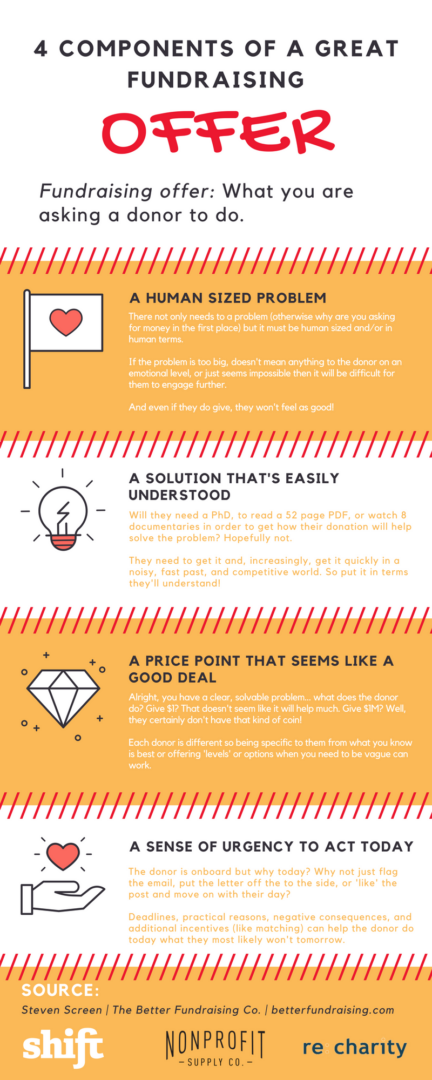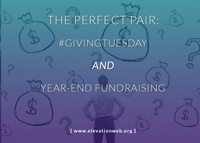How much time have you spent thinking about your fundraising offer? Researching your fundraising offer? Understanding what a fundraising offer even is? I’ve spent a decent amount of time in the fundraising and nonprofit space (my entire career) but when I chat with or read older, wiser, and more experienced fundraisers like Tim Kachuriak from NextAfter, Jeff Brooks from Moceanic and Steven Screen from The Better Fundraising Company, a common key element to fundraising comes up: the fundraising offer.
The fundraising offer is simply what you are asking a donor to do.
And while I have thought about offers, specifically how to use incentives to increase urgency and make things tangible to combat a sense of futility, I don’t think I’ve spent nearly enough time considering the fundraising offer in my own work, life, and career. And that’s a shame.
Who knows how more effective campaigns, ideas, and appeals would’ve been if I’d given the fundraising offer the time and attention it deserves. Steven, and Jeff Brooks, say the audience, who is 40% of fundraising, the offer, what, is 40%, and the creative, how, is just 20%.
Steven Screen from The Better Fundraising Company on Fundraising
Listen on: iTunes | SoundCloud | Stitcher | Google Play
Are you spending 40% of your time thinking of a great and compelling offer to donors? I’m guessing you, like me, spend most of your time looking at how a page is designed, or the phrasing of copy, or how many emails, ads, and letters you will send and how you’ll track it. Not that those things aren’t important (particularly the tracking) but if the offer is crap, then you can have the best creative or tactics in the world but your fundraising will always be limited.
So what makes a great offer and how can you do it? Glad you asked… based on the interview with Steven and some writing from Mr. Brooks, here are…
4 Components Of A Great Fundraising Offer [INFOGRAPHIC]
Let’s break those down a bit more:
1. A Human Sized Problem
There not only needs to a problem (otherwise why are you asking for money in the first place) but it must be human sized and/or in human terms.
If the problem is too big, doesn’t mean anything to the donor on an emotional level, or just seems impossible then it will be difficult for them to engage further.
And even if they do give, they won’t feel as good!
Questions to ask:
- Do you have a problem for donors to solve?
- Does the problem seem solvable to the average donor?
- Is the problem put in human terms?
Let’s face it, some of the problems you are trying to address are not ‘human sized’. Look at our world today and there are issues and areas that seem unsolvable. But breaking down a big problem into a smaller chunk – time, cost, or scope – can help. And putting in human terms – here’s a story of one person who is or will be impacted – is also hugely important. It not only brings a more emotional side to your offer but can communicate a big problem in a way that means more to us as humans.
Wisdom from Jeff Brooks:
This part of the fundraising offer is not for the faint of heart. It takes guts and an unflinching, eyes-open approach to vividly portray a problem that will motivate donors to act. People on your team who are timid, paranoid or bureaucratic-minded will not like it!
2. A Solution That’s Easily Understood
Will they need a Ph.D., to read a 52 page PDF, or watch 8 documentaries in order to get how their donation will help solve the problem? Hopefully not.
They need to get it and, increasingly, get it quickly in a noisy, fast past, and competitive world. So put it in terms they’ll understand!
Questions to ask:
- Will your ideal average donor understand the solution?
- Could a donor re-tell the solution to her friends?
- Can you make the solution simpler by adding complexity later on in the donor journey?
This area was one of my biggest mistakes because I loved the solutions of organizations I worked for so I would, inadvertently, jump to how we were sustainable, unique, innovative, but in doing so I created more confusion and questions for the donor. If you’re passionate about who you help and how – that’s great – but you have to work even harder to fight against over complicating your solution.
Wisdom from Jeff Brooks:
If the problem is hunger, the solution should be food — even if your organizational goals center around economic empowerment, civil society, or anything similarly lofty and abstract. Remember, those things are effective at eliminating hunger because they result in food. Most donors aren’t going to follow the winding trail that leads from civil society to a child rescued from death’s grip. And why should they? Do you know how your cell phone works, or do you just want it to work?
3. A Price Point That Seems Like A Good Deal
Alright, you have a clear, solvable problem… what does the donor do? Give $1? That doesn’t seem like it will help much. Give $1M? Well, they certainly don’t have that kind of coin!
Each donor is different so being specific to them from what you know is best or offering ‘levels’ or options when you need to be vague can work.
Questions to ask:
- What are reasonable and relatable price points for each donor group?
- What do those price points buy, get, or allow?
- How will the donor be able to know or see this in action?
Having a price point that seems like a good deal isn’t about chopping up your program budget, getting ‘restricted’ funds, or lying to donors. It’s about telling them, as specifically as you can, what a certain amount of money, when entrusted to you, will do. If you ask for $50, for example, think about a donor asking you what that did 6 months down the road, what would you say? That’s how you can start answering the price point question.
Wisdom from Jeff Brooks:
It’s a good deal. Everyone loves a bargain. The best offers meet that need by giving donors “bang for the buck.” (That exact phrase has been brought up by donors in virtually every nonprofit focus group I’ve observed.) Whatever the cost of the offer, it has to seem amazingly low for what it accomplishes.
4. A Sense of Urgency To Act Today
The donor is onboard but why today? Why not just flag the email, put the letter off the to the side, or ‘like’ the post and move on with their day?
Deadlines, practical reasons, negative consequences, and additional incentives (like matching) can help the donor do today what they most likely won’t tomorrow.
Questions to ask:
- Is there a deadline?
- Is there a practical reason?
- Is there a negative consequence if they don’t act?
- Is there any other incentive?
This is where countdown clocks, thermometers, matching gifts, 100% overhead covered or 100% goes to overhead offers, and seasonal dates all come into play. And don’t underestimate their importance. You can do #1, #2, and #3 well but if the donor can easily ignore the appeal or put it off, it’s almost all for naught.
Wisdom from Jeff Brooks:
Give your donor specific reasons not to delay her response. If a donor puts the decision aside for later, the chance of it happening drops dramatically. If you did a good job describing the problem (see element No. 1), you already have a lot of urgency.
Why Is An Offer So Important?
The fundraising offer is important for two main reasons:
- A great fundraising offer gives people an understandable, action-oriented way to engage with you.
- A great fundraising offer gives your organization a great storytelling, impact, reporting, and trust building opportunity (re: stewardship).
That second point is incredibly important. As you look to bolster donor retention rates, show more impact, and connect with an increasingly demanding donor (in a good way), if you don’t present a specific opportunity for a donor to give it’s harder to give them a specific update to show impact and earn trust.
The greatest email I ever received from charity: water – where they reported back on my gift with a progress update, ‘you’ language, video a and reminder of what I supported – was only possible because they had such a tangible and specific offer. The fundraising offer creates the trust building opportunity later down the road. If you can use that opportunity then you’ll build trust, earn more donor loyalty, and you’ll each be better off in the long run. But if you don’t
But… if you don’t follow up or can’t, then it not only undermines your past offer and relationship with the donor, it makes your future offers less trustworthy and credible. If you ask me to give $50 that can help give food to a kid for a month, sweet, but at some point, you need to tell me that some kids got some food in part because of my donation.
So…
The fundraising offer is hugely important to making sure you have a great campaign and can engage donors in fundraising that is understandable and compelling to them. It also creates a wonderful opportunity for you to earn more trust by ‘closing the loop’ and reporting back on the outcomes and impact of the offer and donations. Be sure to give your fundraising offer the time and attention it deserves. Your organization will be better for it and your donors happier because of it.
Looking for more on offers?
Jeff Brooks has a great presentation, below, on how he presents and builds offers (blog post here) and a nice summary of the core elements of a great fundraising offer in a post here.




